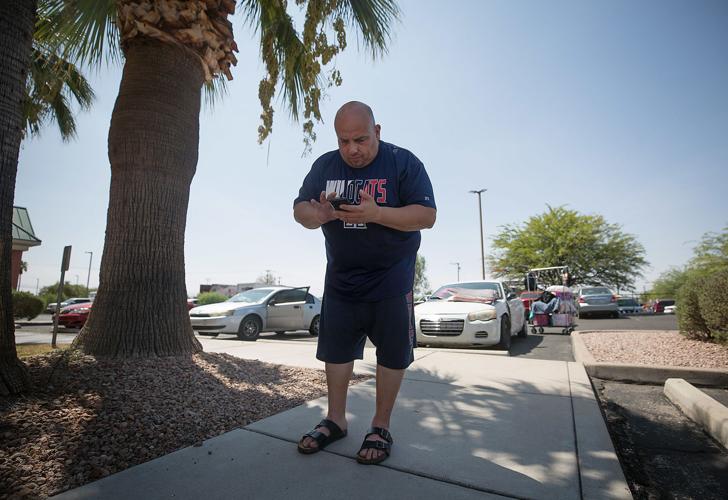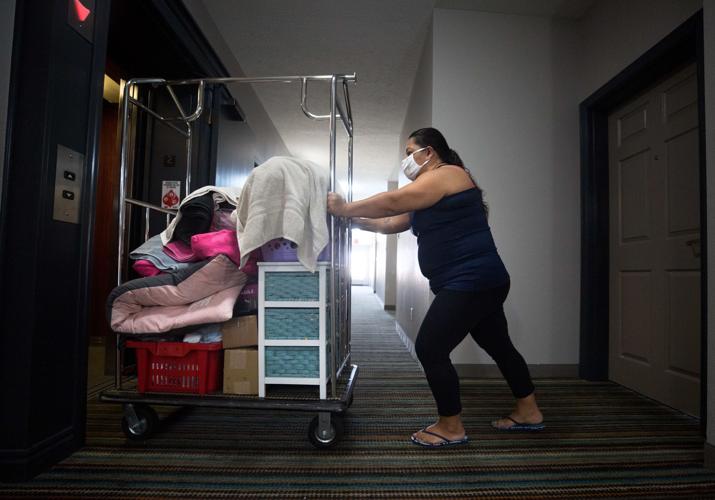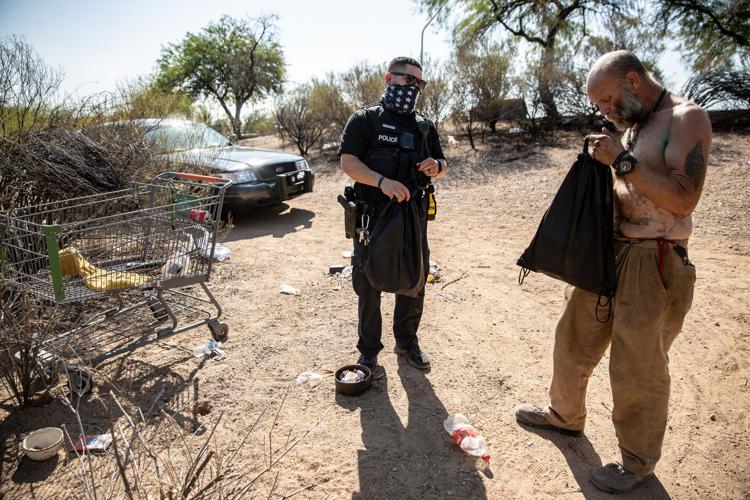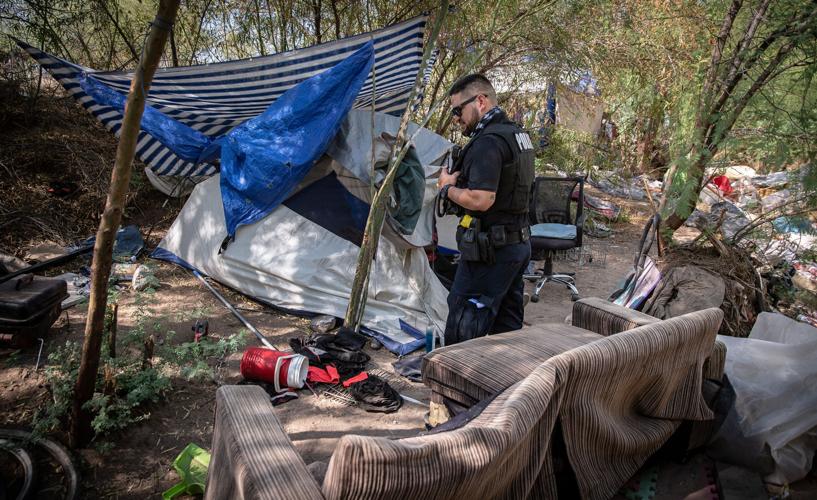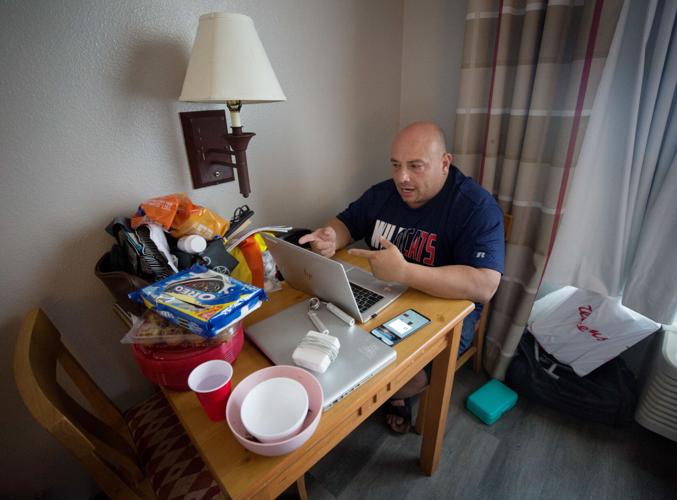Emilio Bustamante was online teaching fifth graders about rectangular prisms when the constable knocked.
The 47-year-old math and science teacher with Sunnyside Unified School District knew an eviction had been ordered, but on that Monday morning nearly a month ago, he thought he had more time.
Arizona Gov. Doug Ducey‘s executive order helped Pima County Constable Marge Cummings delay an eviction during the weeks it took Bustamante’s court case to reach its end, but the outcome was still the same: The Bustamante family became homeless during the pandemic because of lost income.
“I was naive I guess,” Bustamante said. “I felt safe, I felt like the order was protecting me and the constable was protecting me, which she was up to that point.”
What he’d needed to avoid the overwhelming stress that ensued, and the eviction now on his record, was simply enough time back at teaching to earn a full paycheck.
But nothing worked in Bustamante’s favor: not the state’s moratorium, not the judge on his case, not the timing of a new federal moratorium and not the system for getting money to cash-strapped landlords.
Bustamante says he applied for rental assistance in June and heard they were eligible in July. He was offered money three days after being evicted.
Without that funding secured, he’d figured he could teach for a couple of weeks and then move, allowing his landlord, an elderly man trying to put his financial affairs in order, to sell the house. That landlord, Paul Hu, declined an interview request for this story.
Looking back, Bustamante now says he can barely grasp how much his life has changed in the last six months, and how it all started when most of his family became sick with the virus that causes COVID-19.
“Not necessarily on the streets”
One in five households statewide is experiencing severe economic strain, University of Arizona researchers report in their recent publication, “Forecasting Homelessness in Arizona During the COVID-19 Crisis.”
“People who are experiencing homelessness are not necessarily on the streets,” said Claudia Powell, associate director of the Southwest Institute for Research on Women. “They might be living with other people after being displaced, and all of that needs to be considered in determining the fallout of evictions.”
Powell and associate research professor Keith Gunnar Bentele, also with SIROW, have been studying how the pandemic is affecting housing and homelessness in Pima County for several months, and their predictions are grim.
Projecting statewide estimates onto Pima County, they believe the number of households in the county at risk of displacement in coming months ranges from 10,406 to 26,606. So far, by their estimations, the number of homeless here has increased by nearly 800 people. That’s an increase of about 58%.
“There needs to be a really comprehensive plan,” said Powell, board chair of the Tucson-Pima Collaboration to End Homelessness, of the time the moratoriums end. “What always comes up is, ‘Where is the money going to come from?’ What I think people really need to focus on is that not doing anything is less compassionate and is going to be much more expensive in the long run.”
Of the Arizonans who are very likely to be evicted in the next two months, 91% said they were using credit cards or loans to meet their financial needs, 88% were using savings or selling assets, and 100% said they were borrowing money from relatives or friends, reports Bentele, in a PowerPoint presentation shared with the Star.
Only a small portion of the county’s newly homeless are victims of the pandemic, said Tucson police Sgt. Jack Julsing, who heads the department’s homeless outreach team. But that’s because, so far, “a lot has been done to keep that number from exploding.”
“Officers contact the homeless hundreds of times a week and, in the past, were not well versed with the resources to refer the homeless to,” Julsing said. “The TPD homeless outreach team is working to make patrol officers and citizens aware of these resources so that the homeless are reached more efficiently and more frequently than ever before.”
Julsing said the team he leads started in February and is focused on connecting people experiencing homelessness to the resources they need.
“The city and county are collaborating on a ‘housing first model’ and the premise of that model is to get homeless people off the streets and directly into permanent housing,” he said, an approach that spares people time in a shelter and then transitional housing.
“It is also more cost-effective, as the average homeless person costs their city $30,000 a year while living on the streets while just $12,000 a year to be permanently housed.”
Unrelenting Stress leads to hospital stay
On Aug. 31, the day of the eviction, Bustamante’s teen daughter, adult daughter, her two young children and the family’s pets went to stay with his mother.
It was a big change for an older woman in a small home, and so Bustamante and his wife told her they’d stay at a hotel but then didn’t. Instead, they bought some fast food, found a quiet lot and tried to sleep in their car.
“We didn’t want to waste any of the money we had,” Bustamante said, adding that he taught class from a Walmart parking lot the next morning.
It’s been a scramble ever since.
Within days of being evicted, Bustamante was hospitalized for dehydration, exhaustion and a possible mini-stroke. The moving, the excessive heat and high stress taxed his system, Bustamante said.
He’s feeling better now, but with an eviction on his record, the family has been turned down repeatedly on new rentals. Over the last several weeks they’ve applied at a couple dozen places and have had to borrow money from his mother to cover application fees and background checks, in total about $500.
They are still looking.
Luckily, they have been able to get some assistance and mostly avoid shelters and instead stay in hotels.
Bustamante’s wife and adult daughter, who was staying with them when the pandemic hit, were the first to lose their jobs.
And while Bustamante didn’t get laid off from Sunnyside Unified School District, his extra sources of income ended. He stopped earning $30 an hour for the after-school diversion program he ran each day, for example, as well as the money he earned working some weekends as a behavioral health tech.
He also wasn’t able to bring in the extra $4,000-$5,000 he usually earns teaching summer school. Because of the pandemic, he was not needed. His wife has tried to get unemployment benefits, he said, but so far has been unsuccessful.
“My wife lost the $3,000-plus a month she was earning as a caregiver,” he said, “and that continues.” Since March, he estimates, their income has been reduced by more than $21,000, and this loss is coupled with now needing to help support their two grandchildren.
“Feels like they’ve been abandoned”
More than six months have passed since Ducey signed an eviction moratorium that needed a key component to work: rapid rental assistance for the landlords. So far, only about $12 million out of $90 million available in eviction prevention funds has been dispensed in Arizona.
And that what’s been most unsettling, said Courtney Gilstrap LeVinus, president of the Arizona Multihousing Association.
“The city of Houston deployed $15 million in eviction relief in hours. San Antonio deployed $33 million,” she said. “Meanwhile, Arizona state and local governments have promised about $90 million in eviction relief funds to help families struggling financially.”
LeVinus said many “mom-and-pop” rental owners rely on rent for retirement income, and they haven’t been paid for more than half a year.
“They’re frustrated,” LeVinus said, “because it feels like they’ve been abandoned.”
The situation has been compounded by the state ending the governor’s Rental Property Owner Preservation Fund after exhausting its $5 million allocation.
“That was the best option for rental property owners, including small businesses, to get direct relief,” LeVinus said. “That money went fast and that was the end of that. Now, again, we’re likely to see a foreclosure avalanche in the coming months. There’s simply not enough relief funding making its way to property owners who have worked in good faith to avoid evictions.”
The current programs require the renter to apply for the assistance instead of the property owner, which LeVinus said is part of the problem “because many renters don’t feel motivated to apply for assistance, given that they can’t be evicted under the moratoria.”
It’s difficult to find a balance between what’s happening for the landlords, and what the tenants face, said Manira Cervantes, program manager for Pima County’s Community Action Agency.
“I believe we need better tenant rights, and I think its timely for that discussion to occur so that changes can be implemented that protect both landlord and tenants,” Cervantes said. “The current five-day written notice to pay or evict should ideally be increased to allow the tenant time to find resources and make a plan.”
COVID-19, she said, “has made us all take a better look at processes, technology and red tape that impacts delivery of services.”
“While we can streamline processes and make internal changes,” Cervantes said, “I only hope that federal changes can occur regarding policies that have been in place for many decades.”
“Quite an ordeal”
About the same time Bustamante and his family moved out of their rental home, another Tucson couple facing financial hardships were able to avoid an eviction.
The difference may have been as simple as timing — with a new eviction moratorium in place from the Centers for Disease Control and Prevention — but something else may have helped even more: legal advice.
In addition to cases taken by Southern Arizona Legal Aid — whose attorneys have helped 189 residents here with COVID-related legal issues and 564 with housing overall from March 1 to Aug. 31 this year — a few other Tucson attorneys have started providing free legal help to tenants facing eviction.
The lawyer who helped Karah and Art Anaya late in their case asked to remain anonymous.
The couple were having financial difficulties before the pandemic started and said they’d set up a payment plan with their landlord for the lot and a rent-to-own mobile home, which Karah Anaya said is almost paid off.
If evicted, they would lose the nearly-impossible-to-move mobile home to the landlord.
Karah Anaya said they were both working in March but lost their jobs — Art Anaya was a groundskeeper, Karah Anaya a caregiver — after the pandemic started. And their financial stress was compounded by delays with both unemployment and rental assistance.
Did she tell the landlord they were having financial problems? Karah Anaya said yes, they notified him by text messaging and in writing, but the landlord’s attorney said no.
“In this case, the Anayas were given multiple opportunities by the judge to demonstrate that they met the requirements for the executive order’s protections to apply,” said the landlord’s attorney, James Landon.
“For whatever reason, they only did so at the last possible moment and by then it was a moot point because the CDC eviction moratorium was in effect.”
When she started to go through the eviction proceedings, Karah Anaya was unsure what to do to prepare for her initial appearance hearing.
After a pro-tem judge ordered an eviction, constable Joe Ferguson delayed it under the governor’s order, giving them a little more time. Ferguson advised Karah Anaya to try to provide the court with proof of their financial hardships, which she didn’t do for that first hearing. Since proceedings are not held in person, documents must be uploaded electronically, which can be a challenge for many people, including several interviewed for this story.
Responding to the delay, Landon filed a motion to compel the eviction.
At the next hearing, now before Judge Vince Roberts, Karah Anaya had uploaded a dozen documents but on the recording of the proceeding, Roberts told her he didn’t have the items, which Anaya said panicked her. She told him she had a receipt. Then, also on the recording, someone — likely a clerk — said there were three documents and that one was handwritten.
Roberts, nevertheless, granted the motion to compel the eviction “in the interest of justice.”
Interview requests for Judge Vince Roberts and for Justice Court Judge Susan Bacal, who presided over Bustamante’s case, were not answered for over a week by Elvia Cariño, the interim deputy court administrator handling media requests for the county’s Consolidated Justice Court.
The Anayas were on the brink of homelessness, but with the help of the attorney, Karah Anaya asked Roberts to reconsider. She was able to argue, at the next hearing, that the ruling was illegal, and that she was being evicted only because of pandemic-related financial hardship, which violated both the governor’s order and, by the time the matter was resolved, the new CDC order.
As many as 500 people in the county could be illegally evicted here by the end of October, said Anthony Young, executive director of Southern Arizona Legal Aid Services. Inconsistencies in the way cases are being handled leaves some tenants vulnerable, he said.
“There are a large number of evictions that never should have been filed in the first place,” Young said. What’s unfortunate is that the state and federal moratoriums are not really preventing evictions, he said.
“Logic would suggest that no one should be relocating their housing under any circumstances other than criminal activity,” Young said. “We are in the middle of a pandemic.”
Evicted “in the interest of justice”
Under Ducey’s executive order, judges are not supposed to order evictions against people who are failing to pay due to pandemic hardships, but they can if the eviction needs to be carried out “in the interest of justice” and for material breaches, such as criminal activity or a significant violation of the lease agreement.
Now, with a new federal moratorium from the Centers for Disease Control and Prevention, evictions are not supposed to happen unless there is a serious material breach. The key is getting the people to sign a form letter so the landlords and courts know what’s happening.
That can prove challenging for a number of reasons, said Kristen Randall, the county’s presiding constable, including people not being aware of the order or not understanding it well enough to sign it.
Since cases started to be heard again here in early June, after the courts were closed for several weeks because of COVID-19, county data shows 472 individuals or families have been evicted.
Some of these evictions were due to criminal activity or a significant breach of the rental contract, Randall said, but others involved people who simply didn’t have enough money to pay.
Now, even with the new CDC order in place, more than 250 eviction hearings have been scheduled here so far in September.
An estimated 365,000 Arizona renters may face eviction within the next four months, with 74,000 of those at risk living in Pima County, a recent analysis by the consulting firm Stout Risius Ross shows.
During the first federal moratorium under the CARES Act, which ran from March 27 to July 24, people living in federally subsidized housing or rental housing with federally backed mortgages were supposed to be protected from the filing of evictions unless there was a reason other than nonpayment of rent, such as criminal activity. The CARES Act also placed a moratorium on all fees and penalties imposed for nonpayment of rent.
Corinne Cooper, a retired University of Missouri law professor who was assisted by University of Arizona law student Stephen Bagger to look at the county’s CARES cases, has shared her research on these cases with the Arizona Daily Star.
In Pima County during that time, 49 cases filed before the moratorium went to judgment with fees and penalties still included, 84 were filed after the moratorium was in effect and, of those, 33 were evictions for cause, meaning they were carried out quickly for a reason other than nonpayment of rent.
An increase in evictions for cause could be because the tenants’ behavior degraded during this stressful period, Cooper said, or “it could be that the lawyers realized that alleging cause was the only way they could get the tenants out during the moratorium.”
In some of the cases, she said, the reason was clear in that a police report was provided or a witness testified about a significant problem. In other cases, however, the cause alleged was trivial, such as garbage being placed beside a dumpster or cigarette butts being left on the property.
A rush to help before moratoriums expire
The city of Tucson is working on 4,000 applications for housing and utilities assistance received during a one-month window, from early August to early September.
The city is not taking any more applications, said Liz Morales, Tucson’s housing and community development director, but it will if more federal funding becomes available.
The time it takes to get through each application is overwhelming, Morales said. “And we’ve contracted out with three agencies, so it’s not for a lack of people,” she said.
Right now, the city has $4.5 million in federal dollars to dispense, Morales said, between Coronavirus Relief Funds and Community Development Block Grant funds.
One of the city’s main objectives? Help as many people with rent as possible before the eviction moratoriums lift.
To help, the state has provided additional funding for staffing to local agencies and is also working to ease eligibility requirements, said Janelle Johnsen, communications officer with the Arizona Department of Housing.
“Impossible for me to appeal”
The eviction of Bustamante, the Sunnyside teacher, was granted “in the interest of justice.” Court documents provide no further explanation except that his request for reconsideration was denied because there were “no legal grounds.”
During Bustamante’s initial hearing, when the eviction order was first handed down in late July, he tried to upload documents but they wouldn’t take. During the hearing, he did not feel he had the opportunity to tell the judge that his whole family had been sick, or that he hadn’t been able to get the documents to her.
Bacal did not set another hearing and instead, after a hearing that lasted less than 10 minutes, ruled for eviction. Bustamante was stunned.
After the eviction judgment was handed down and his case continued, Bustamante wanted to file an appeal but couldn’t afford it after Bacal set a bond of nearly $6,000, the amount he owed in back rent, restitution and late fees as part of the judgment.
The purpose of the bond is to ensure a landlord or property owner still gets reimbursed, but Bustamante, who tried to get the judge to waive the amount, said his landlord had already told the court he didn’t want the back rent or fees, he simply wanted the house empty so he could sell it.
Could Bacal have allowed him to appeal?
Under the rules of procedure outlined by the Arizona Supreme Court, judges presiding over eviction case can “waive the cost bond if the appellant files a satisfactory affidavit of his or her inability to pay.”
The high court also urges judges, in providing guidance about how to handle these cases during the pandemic, to “liberally grant continuances and make accommodations” for anyone struggling to participate in their proceedings.
In the end, neither helped Bustamante, who did not have the expertise to make legal arguments.
When he was distraught in the weeks after his eviction, Bustamante would sometimes text Bonnie Bazata, program manager with the county’s Ending Poverty Now, whose agency had helped him.
On one particularly bad night, Bustamante sent Bazata a message saying he felt like he’d failed his family.
Bazata quickly set him straight.
“She said to me, ‘No, Emilio, you did not fail your family. The system failed you.’”


